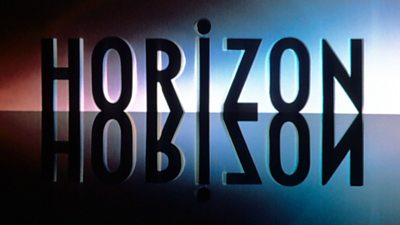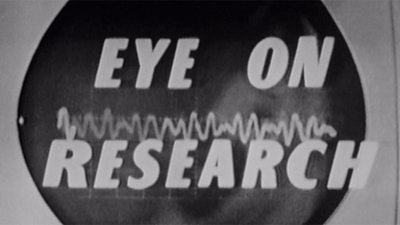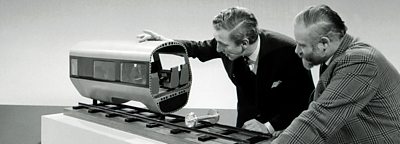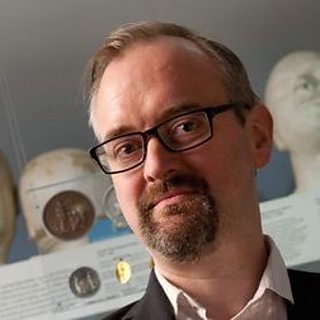Raymond Baxter and Bob Symes with a model of the new advanced passenger train on Tomorrow's World in 1969.
2024 - the year the ����ý marks 60 years of Horizon. Looking ahead, 2025 provides the corporation with not one but two significant anniversaries in science TV: of the natural history series Look, which started in 1955, and Tomorrow's World, which began in 1965. In many ways the decade, bookended by these two premieres, was the formative period for science broadcasting.
Two linked factors were being worked out by ����ý producers in those early days. The first was how to play to television's strengths as a live medium whilst retaining a commitment to quality programming. The second was to find the right kind of performers to bring science alive on the small screen. The same factors were at play for both natural history programmes (made in Bristol) and for those covering the rest of the sciences (produced in London).
Look
Look was the first regular natural history programme on British television, between 1955 and 1968. Its established format was to show films made by a range of specialist naturalist-cinematographers, interposed with studio introductions and discussions. The Radio Times listing for the first programme on December 16th 1955 gives the tone:
Introduced by Peter Scott / Heinz Sielmann, introduces his own film of foxes in the wild.
Other filmmakers included Walter Higham, Lord Alanbrooke, and HG Hurrell. It is fascinating to watch these old programmes. In some ways they have much in common with today's science TV, notably in the importance of the presenter and in the emphasis on the power of the camera to reveal the secrets of nature.
In other ways, the programmes seem a world away, with their slow pace and gentlemanly style of narration; very sober compared to today's presenters: what the camera reveals to Scott is "rather nice" instead of the "absolutely amazing" that we are used to with today's presenters. You can see the style in these excerpts from the 1961 edition that featured a retrospective of veteran bird cinematographer Walter Higham:
Look had the aesthetic of a live programme, with Scott sitting in a studio mock-up of his own study, providing introduction, conclusion, links and commentary. But most of the visual material in the programmes came from the nature films shot by people like Higham; naturalists rather than biologists, and amateur scientists rather than university-based professionals.
There were significant social factors – class, profession, age and gender – that gave the programme its authority. In the first place, Peter Scott, knighted in 1973, was well known as the son of Robert Falcon Scott – 'Scott of the Antarctic' – and was a privately educated unsuccessful Conservative candidate in the 1945 election, who had famously established The Severn Wildfowl Trust at Slimbridge in 1946.
The implication of the programme is very much of the viewer being invited-in to overhear a private film show with a well-informed voiceover from Scott, or from a range of other male, middle class, middle-aged presenters. This was at a time before the social revolutions of the 1960s, when such attributes were still expected to convey authority and reliability in a way that only later became open to widespread questioning.
Eye on Research
The true precursor to Tomorrow's World (1965-2003) was not Look but Eye on Research, the first long lasting regular science and technology series on ����ý TV, which ran between 1957 and 1962, in which time over forty editions were broadcast, as can be seen from a quick search on .
Eye on Research was a topical, live series that took outside broadcast cameras out into scientific laboratories and research stations on weekdays when the equipment wasn't needed to cover sports fixtures. Being live, the programmes generally needed the services of a reporter on the spot to mediate between the expertise of the scientist and the viewer at home.
In the first series they used the Manchester journalist Robert Reid. Thereafter it was Raymond Baxter who fronted the programme. The reporter was on screen to be the viewer's proxy in relation to the scientist, introducing the subject, questioning scientists, and simplifying and summarising their responses.
It is the communication skills of a Baxter, combined with the expertise of the scientist on screen, that gave these programmes their authority, as can be seen in the first few scenes of the programme that came live from Cern on 24th February 1959:
The authority of these Eye on Research programmes comes directly from the interplay between Baxter and the scientists. The style, like that in Look, is still very gentlemanly; Baxter’s received pronunciation vocal tones mean that the programmes retain something of the class nuance of the other programme, even though he was a grammar school boy, rather than sharing Scott's private school education. At the same time, his ease in front of the camera served both to get a good performance out of his – often very nervous – scientist-interviewees.
The highly technical level of the programme (much more difficult than Look) probably contributed to the series being axed in 1962. This had a dramatic result on Horizon, the programme that succeeded Eye on Research. The producers, led by Aubrey Singer, head of department, steered away from topical 'science news' programmes – and from having a non-scientist like Baxter as presenter.
Horizon was to be about the culture of science, emphasising the individuals involved and, over the series, adding up to a portrait of what scientists were like as people.
Tomorrow's World
Tomorrow's World, which began to be broadcast on ����ý1 the year after the ����ý2 series Horizon, went back to some of the features of Eye on Research. It started as a live, topical science news programme, and welcomed Raymond Baxter back to science broadcasting.
The existence of Tomorrow's World, a live, topical, magazine programme freed up Horizon's producers to adopt the style that it has been known for for much of its 50 years; a more stately film documentary with commentators rather than reporters. Baxter stayed with Tomorrow's World until 1977.
In this, the first ever programme, we see Baxter as anchorman rather than reporter, introducing and providing voiceover for the programme's items. Perhaps this was a promotion in status for this most authoritative of science presenters:
Find out more about Horizon
-

Horizon at 60
A celebration of the long-running science programme by Dr Tim Boon and Dr Jean-Baptiste Gouyon from The Science Museum. -

The other side of Horizon
The science programmes that came before -

Horizon 60 interviews
A sequence of interviews with the makers of Horizon over its 60 years.

